Last Updated on July 11, 2025
I witnessed some crazy wildfires back when I lived in California. The Atlas and Patrick fires both burned less than 15 miles from my home in 2017.
As someone who’s lost everything to fire before, it was an incredibly uneasy and tense time. And it only seems to be getting worse – the Canadian wildfires were so bad in 2023 that the smoke reached New York.
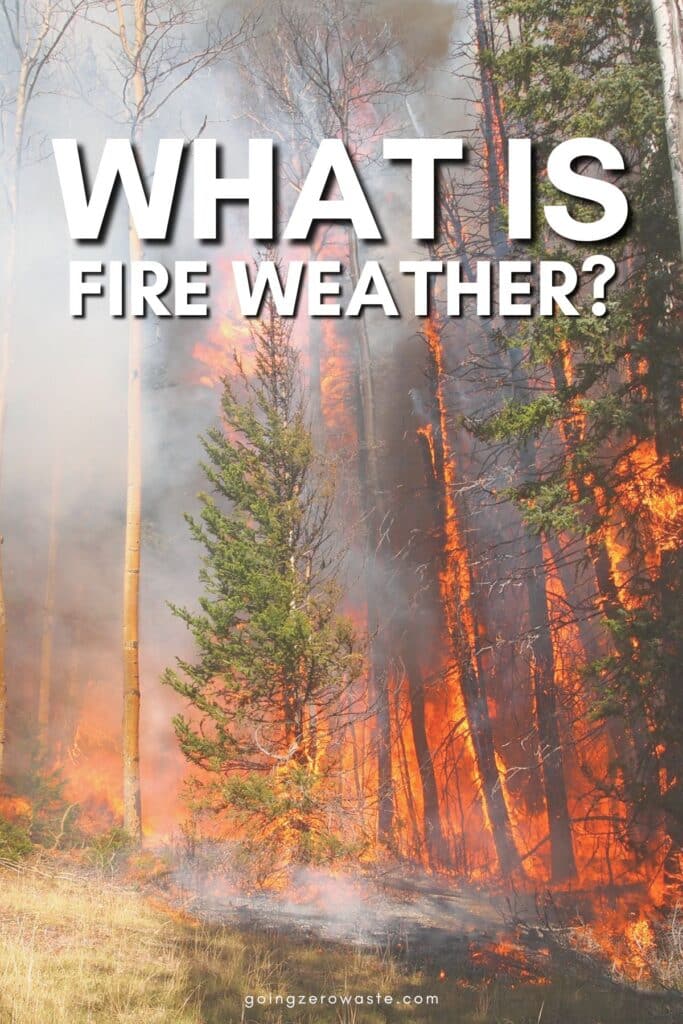
Wildfires aren’t always linked to climate change – sometimes they’re started by arsonists, mismanagement, or natural causes. But climate change is definitely making wildfires worse and more frequent – leading to something called fire weather.
But what exactly is fire weather, and how can we prepare for it? Is there a way to prevent it? Here’s everything you need to know to keep yourself informed, safe, and ready.
what is the definition of fire weather?
Fire weather refers to any time the conditions are right for a blaze – typically issued as a warning when an area has been too hot, dry, and windy for substantial amounts of time. Fire weather doesn’t mean there are any actual fires – it simply means there could be.
According to NOAA, fire weather watch alerts will be issued whenever these three critical elements are met:
- sustained winds averaging 15 mph or greater
- relative humidity 25 percent or less
- temperature 75°F or greater
When these fire weather conditions are met, the landscape is primed for really disastrous infernos that can be difficult to control and put out.
For instance, The Camp Fire of 2018 moved so quick that it overwhelmed the city of Paradise, killing 86 people, many trying to leave in their cars.

what are the 5 critical fire weather conditions?
The five critical fire weather conditions include high air temperatures, low precipitation, low soil moisture, low relative humidity, and gusty winds. When you mix all five of these together, you get ample weather that fuels fires.
Here’s a deeper dive into each element:
- High air temps: Very warm temperatures can strip moisture from easily combustible materials, like grass
- Low precipitation: Lack of rain or snow, or in extreme cases, a drought
- Low soil moisture: When soil moisture is low, vegetation is likely dry and stressed, making it easy kindling
- Low relative humidity: If there’s a lack of water vapor in the air, it makes kindling (grass, brush, etc) easier to burn
- Gusty winds: Winds can strengthen flames, should a fire ignite
how do you prepare for fire weather?
The best way to prepare for fire weather is to stay on top of weather conditions. Springtime is when most wildfires occur, but secondary fire weather season occurs during fall.
Be mindful that climate change affects wildfires, making them more common and less predictable. Be sure to monitor alerts on your phone and check National Weather Service (NWS)’s fire weather map consistently.
Another way to prepare for fire weather is to create an action plan, in case there is a fire. You should research and check your location on FEMA’s website to get information about disaster declarations in both the past and present.
Listen for wildfire evacuation orders and take them seriously: Devise a plan with your family members so you all know where to regroup and meet, should you have to evacuate.
Having a bug out bag full of supplies is a great idea. A bug out bag can be stashed under the bed, in a closet, or in a car – but it should be somewhere you can easily access.
Here’s what to pack in a bug out bag:
- First aid kits
- Medications + supplements
- Physical maps (important if you lose GPS signal)
- Essential documents (passport, insurance, birth certificate, etc.)
- Flashlights
- Pet food + supplies
- Non-perishable food (canned goods, trail mix, etc.)
- Water (4-pack of aluminum bottled water)
- Extra phone chargers (Nimble is a sustainable brand that uses recycled materials)
- Solar powered radio
- Extra clothing and pairs of underwear (ideally enough for a week)
- Toiletries (safety razors, shampoo bars, body wash, etc.)
- Menstrual care products (Kayaness and/or organic tampons)
RELATED: How to Build An Eco-friendly Emergency Kit

how can we reduce chance of wildfires?
Obviously being prepared for the worst is important, but what if we could reduce their occurrence? Good news:There are several ways we can reduce the likelihood of fire weather alerts (and wildfires in general).
controlled burns
It may seem counterproductive, but doing controlled burns will help reduce wildfires. Why? Because a planned fire can remove dead grass, fallen tree branches, dead trees, and thick undergrowth – aka, the kindling that fuels wildfires.
Planned burns are done when weather conditions are not fire weather conditions – and can be properly controlled and monitored. Ash from burnt vegetation also releases nutrients back into the soil, allowing for new vegetation to grow and promoting biodiversity.
You can learn more about controlled burns via Nat Geo but it’s important to note it’s nothing new – indigenous people have been practicing controlled burns for decades. We can advocate for more controlled burns by writing to our local reps, learning more about them, and simply spreading awareness.
tackling climate change
By having strong climate policy in place, we can ensure fire weather becomes less common. Voting for people who vow to protect the environment – both on local and national levels – is essential to this.
Getting involved in your government, emailing and calling your local reps, and volunteering your time at environmental non-profits are all great ways to fight climate change on a collective level.
On an individual level, taking steps to reduce your own carbon footprint too (like switching to renewable energy and driving less) is also a great idea. And of course, don’t forget to make plastic-free swaps or start composting if you haven’t yet!
RELATED: 4 Ways to Fight Climate Change as One Person
creating drought tolerant lawns
If you live in a state that’s prone to droughts (like California), investing in drought-tolerant landscaping is a great way to reduce risk of fires. Drought-tolerant plants require less water and can be less susceptible to igniting.
Xeriscaping is worth looking into, as well as planting fire-resistant plants (agave, succulents, red yucca, etc).
Looking into native plants is also worth checking out, as these plants require less maintenance and tend to be more durable in your specific climate. My friend Shelbi recently turned her lawn into a native pollinator habitat and I’m here for it!
Do you have any questions on fire weather? Let me know in the comments!
The post What Is Fire Weather? Is it Preventable? appeared first on Going Zero Waste.
Green Living
How Toad&Co’s Clothes Help Everyone Enjoy the Outdoors
This is a sponsored article about a brand that was independently assessed by our rigorous ratings system. We’re proud to only collaborate with “Good” and “Great” rated brands. Learn more.
US brand Toad&Co has a socially and environmentally responsible approach to clothing, creating pieces inspired by the outdoors and with a lower impact on the environment. Not to mention an enduring commitment to helping everyone get outdoors through its work with non-profits. Read on to discover the brand’s environment-first ethos.
Focusing on what matters most
“We make feel-good clothes for positive impact—fostering community around doing good, enjoying life’s simple pleasures, and embracing the unexpected,” says Sarah Palladino, director of people and impact at Toad&Co as she introduces the Californian brand. This “simple pleasures” concept applies to Toad&Co’s approach to design, too, and prioritises quality and responsibility over trend-led items. This, in turn, means the brand focuses its energy on clothes that are comfy and practical enough for everything from work to outdoor exploring, and on maintaining its ongoing commitments to using lower-impact materials, partnering with cleaner factories, and looking for new ways to do more with less.
Since day one, it’s been about more than just clothes. From choosing sustainable practices in every corner of our business to supporting programs that protect the planet and make the outdoors more accessible to everyone—knowing we stand for more is what keeps us going
Gordon Seabury – CEO at Toad&Co
Lower-impact materials and producer responsibility
Opting for lower impact materials is one of the core ways brands can address their impact on the planet: “Sustainable materials make a world of difference,” Toad&Co says. “We use organic cotton, recycled fibres, and other high-quality materials known for low-impact growing and cleaner manufacturing.”
The brand’s selection of more sustainable materials includes organic cotton, hemp, TENCEL Lyocell, and recycled fabrics like wool, cotton, and polyester. It also looks to third party clothing certifications like bluesign®, OEKO-TEX® STANDARD 100, and Global Organic Textile Standard, and it publishes its list of restricted substances for all to see.
Toad&Co also operates a resale platform, called ToadAgain, online and at its IRL store in Maine, US, to keep its clothes in the loop.
Supporting non-profits and access to the outdoors
Toad&Co donates 1% of its profits to organisations working to empower others and, in particular, enable better access to the outdoors for all.
In 1996, Toad&Co partnered with Search, Inc. to co-found the Planet Access Company, a full-functioning warehouse that trained and employed up to 70 adults with disabilities annually.
Determined not to stop at the front door, the brand also co-founded Search for Adventure in 2004, a unique travel program to facilitate vacations for adults with disabilities. Over 20 years later, the social venture partnership has evolved—and includes a flagship store in Chicago, a program called Visibility Arts that nurtures creativity through sharing Search, Inc. artist’s work, neurodiversity and disability awareness training, and an expanded Search for Adventure program. In 2024, the brand supported 147 nights of camping for adults with disabilities through the program.
We give back to—and partner with—organisations that align with our three pillars of giving: conservation for human enjoyment, equity and accessibility, and do the right thing
Sarah Palladino – director of people and impact at Toad&Co
One of Toad&Co’s key partnerships is with Brave Trails, which is dedicated to LGBTQ+ youth leadership, to support it in putting on accredited camps, mentorship programs, and meet-ups for LGBTQ+ youth.
Shop favourites from Toad&Co’s new collection
Read on to discover some of the standout items that balance style with practicality from Toad&Co’s lineup.
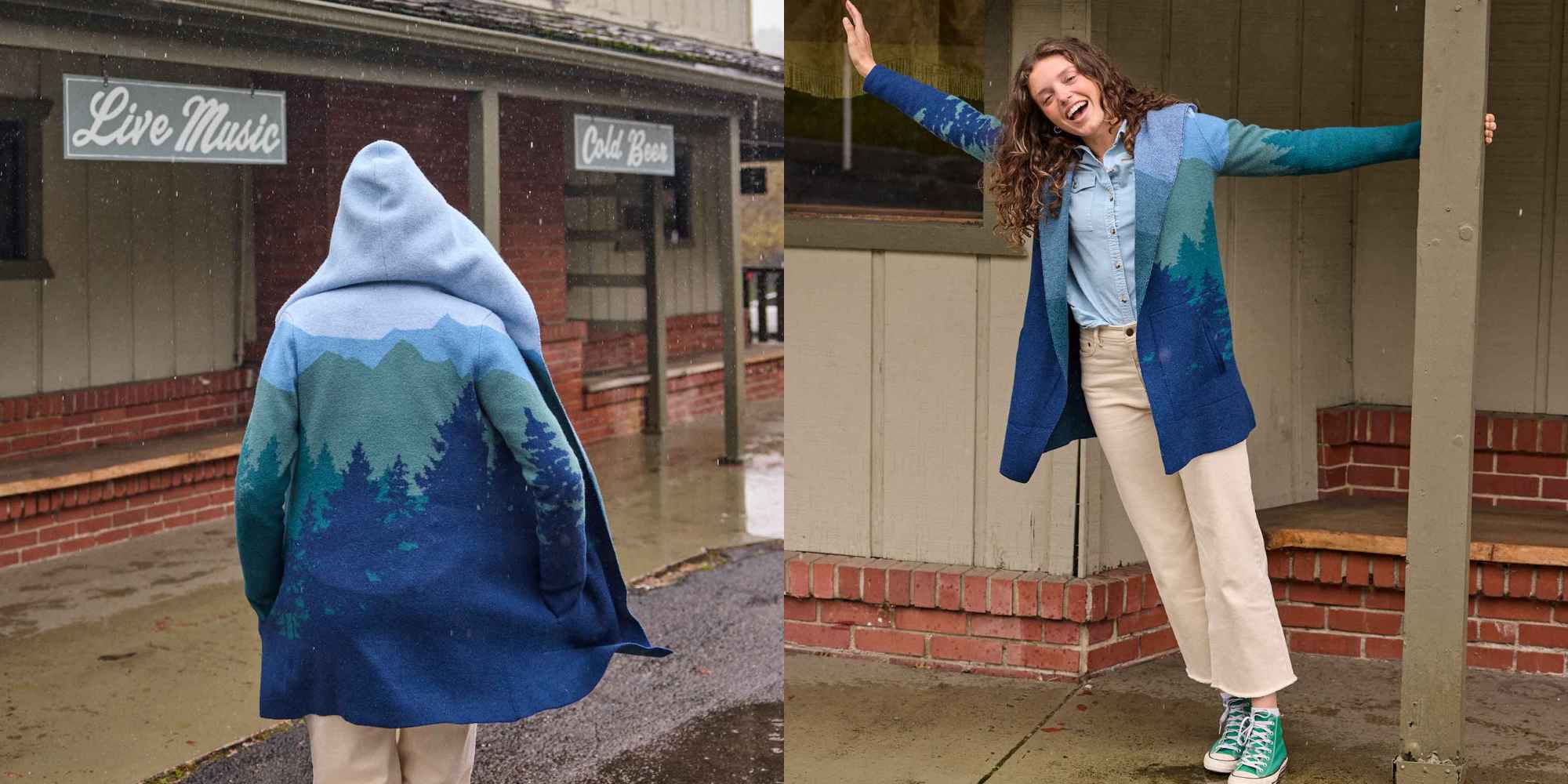
Woven with a beautiful alpine jacquard pattern, this hoodie is made from non-mulesed Merino wool and features pockets at the sides. It’s ideal as a mid-layer under a longer coat when you’re out exploring, or as a cosy item for grabbing a post-walk hot chocolate.
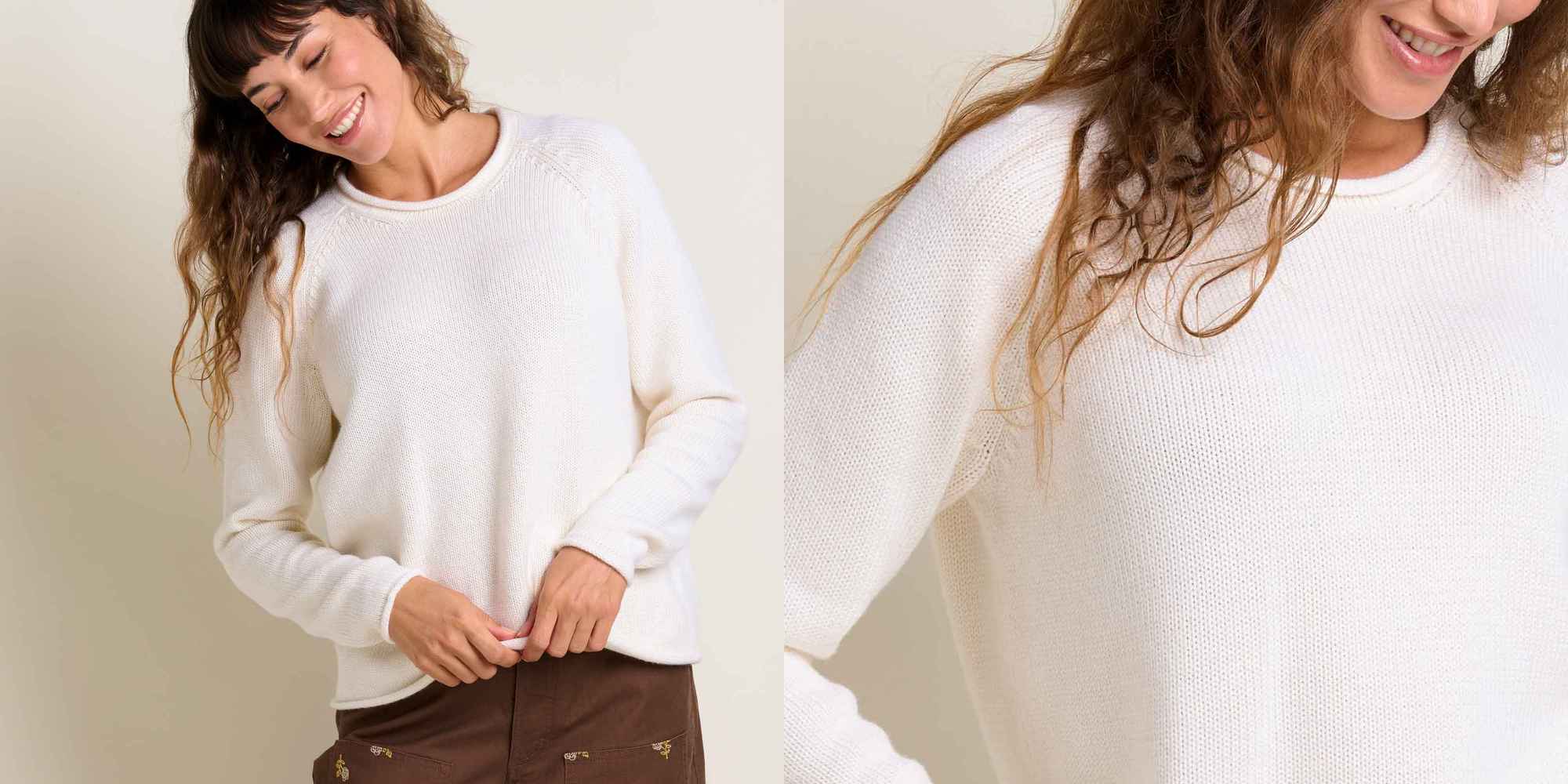
This Alpineglo sweater is a blend of 50% organic cotton and 50% non-mulesed Merino wool, so it’s going to help regulate your temperature in most climates. On top of that, the neutral tone and straight fit make it really versatile—you’ll be reaching for it on the regular.
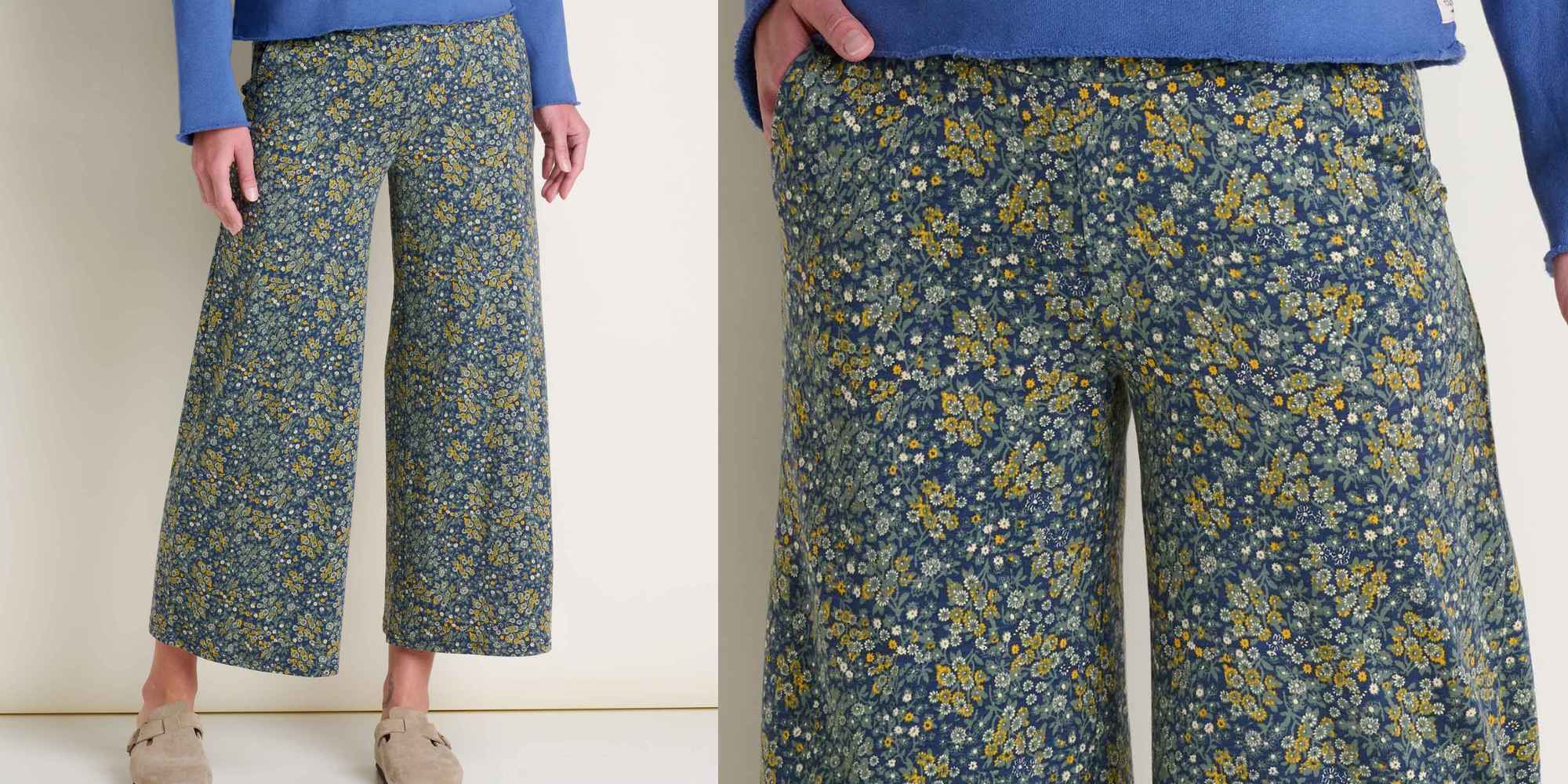
Toad&Co calls these cropped trousers “sweatpant comfortable, going-out presentable”, which makes sense, given they’re made with organic cotton and Tencel Lyocell for softness and have a comfortable wide waistband, not to mention a pretty floral pattern.
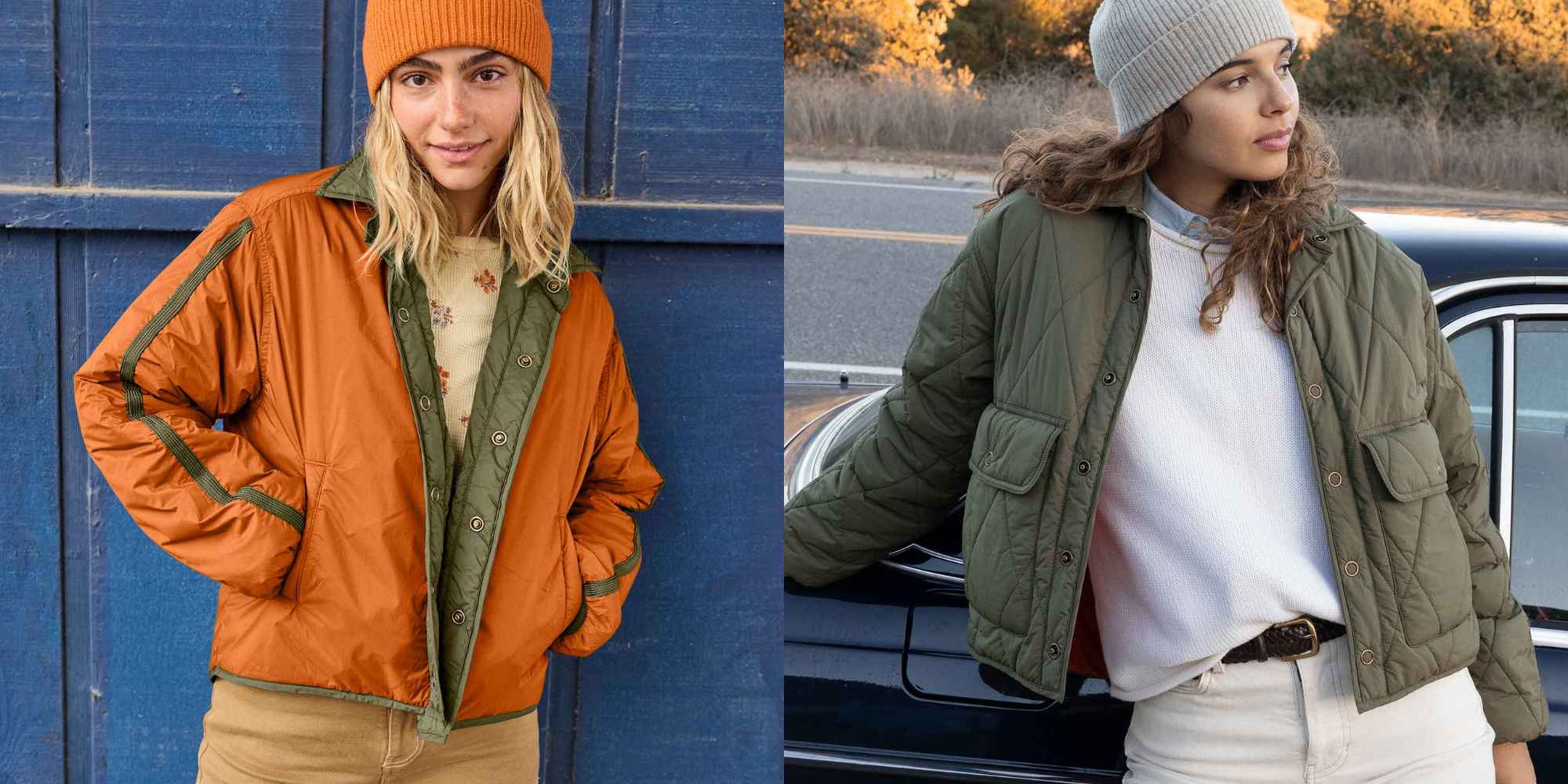
This Nomader jacket is reversible, packable, and water-resistant. In other words, it’s the ideal item to take with you for outdoor adventures. It’s made from recycled nylon and lightly quilted for warmth.

Toad&Co picked the crepe-like organic cotton for this jacket so that you could fold it away in a bag and have it still look presentable when you pull it out. It’s also packed with recycled polyester padding for extra warmth.
 Balsam Cutoff TrousersThese Balsam Trousers are made with a tiny bit of stretch and a special waistband for comfort, so they’ll flex with you and feel good all the time. The neutral brown colour also goes with so many options.
Balsam Cutoff TrousersThese Balsam Trousers are made with a tiny bit of stretch and a special waistband for comfort, so they’ll flex with you and feel good all the time. The neutral brown colour also goes with so many options.These Balsam Trousers are made with a tiny bit of stretch and a special waistband for comfort, so they’ll flex with you and feel good all the time. The neutral brown colour also goes with so many options.

Going from a walk to dinner? From the office to drinks? This Kennicott shirt jacket fits the bill for all of the above. The smart twill fabric incorporates recycled Italian wool.

This is Toad&Co’s Re-Form Herringbone: a blend of recycled cotton and polyester that offers a soft drape and an attractive herringbone weave that looks smarter than the average checked shirt.
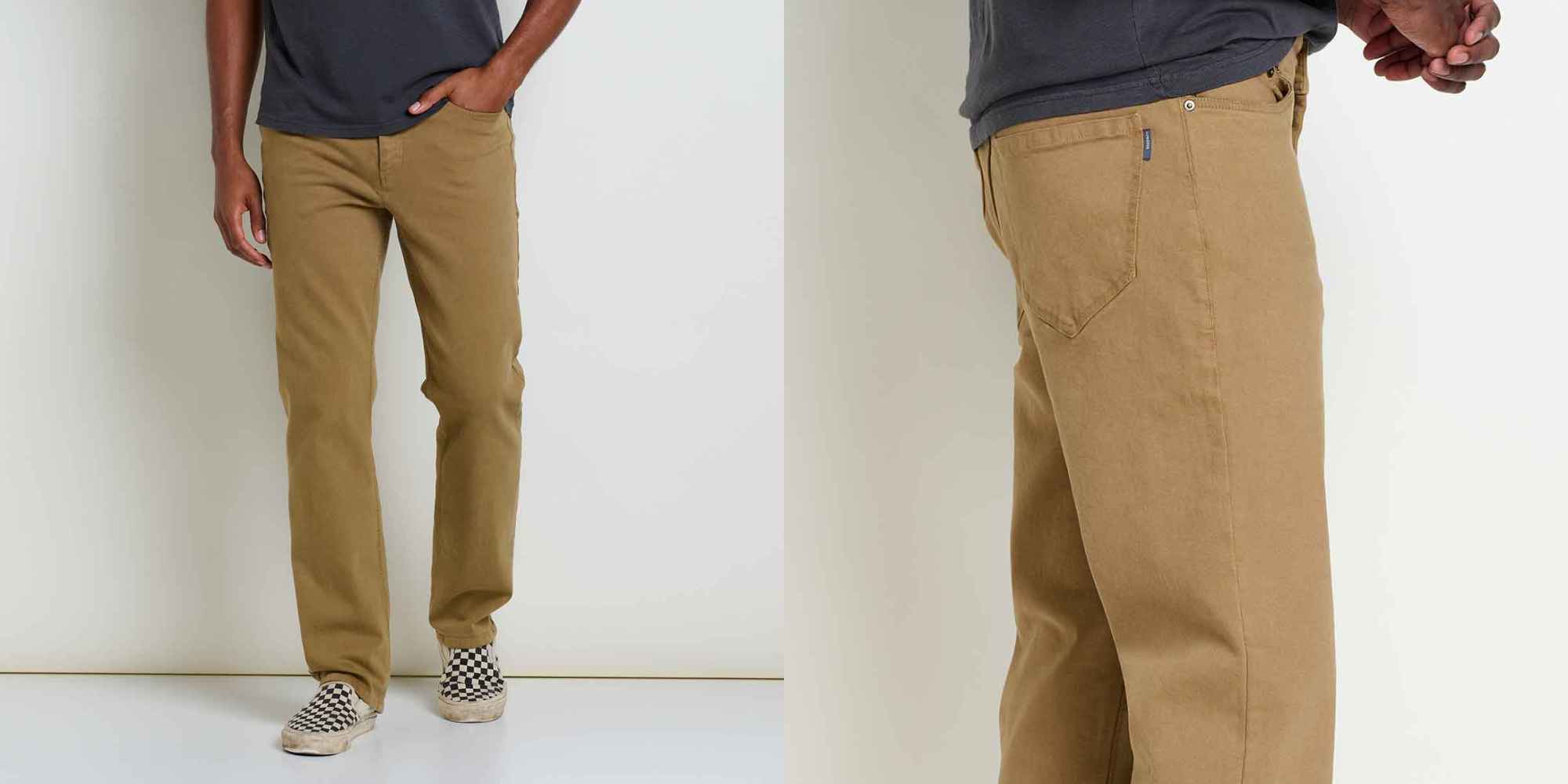
Like the women’s equivalent, these Balsam trousers have a touch of stretch and a comfortable ‘FlexForm’ waistband that mean they’re going to feel comfortable from the get-go—and you won’t need to worry about a belt, either.
Discover more of Toad&Co’s clothes.
The post How Toad&Co’s Clothes Help Everyone Enjoy the Outdoors appeared first on Good On You.
Green Living
50 DIY Christmas Presents Anyone Can Make
Last Updated on November 21, 2025
If you’re on the handmade Christmas kick this year, you’re not alone. So am I!
I’m choosing presence over presents this year and bringing back the 90s Christmas I loved as a kid – simple, crafty, low pressure, and full of small moments that feel meaningful.

If you want to gift thoughtfully, and without breaking the bank, these DIY Christmas presents are for you. There’s something for everyone on this list – whether you prefer easy or complex DIYs.
I’ve included all kinds of DIYs – beauty, cooking, fashion, and practical gifts alike. Best of all? Many of these tutorials are zero waste (or close to it).
what are good homemade Christmas gifts?
Good homemade Christmas gifts include consumable items, like homemade nut butters, vanilla extract, or jams. But not all homemade gifts are edible – you can also make items like bath bombs, candles, body scrubs, beeswax wraps, and so much more.
If you’re extra crafty, you could even make wooden gifts (like shelving or tablet holders), ceramic items (like mugs or jewelry), or knitted/crocheted pieces (like blankets, scarves or hats).
It all depends on your level of skill, time at your disposal, and ingredients/materials you have access to.

what are good inexpensive Christmas gifts?
Some good inexpensive Christmas gifts are DIY cornstarch ornaments, handmade body or lip scrub, seasoned salt blends, and homemade treats (like these chocolate chip cookies or vegan sugar cookies).
And never forget to hit up your local thrift store – you can find so many great items that would make affordable gift baskets!
Wrapping DIY Christmas gifts also doesn’t have to be expensive. Reusing gift bags and ribbons from last year, upcycling packaging paper, or even repurposing a scarf for furoshiki wrap are all low-waste and affordable!
RELATED: Gift Wrapping: How to Keep It Easy, Eco and Chic
how can I make a last minute gift?
You can make a last minute gift by getting crafty using the materials you have on hand!
For example, if you have a cardboard box, why not try making an upcycled cardboard dollhouse, vehicle, or pirate ship for a child? For adults, a DIY storage container or a shoe rack works.
One of my fav last minute gifts is scented bath salts in an upcycled glass jar – just a little Epsom salt and essential oil blends will do the trick!
Here’s my list of DIY Christmas gifts – something for everyone and every skill level.

- Bath salts
- DIY makeup like mascara/eyeliner, or lip to cheek
- Bath bombs
- Lip scrub
- Lip balm
- Face mask
- Body lotion
- Natural perfume
- Dry shampoo
- Shampoo bar
- Body soap
- Deodorant
- Rose water toner
- Hand-poured coconut/soy/beeswax candles
- Simmer pot in a jar
- Cookie, brownie, soup mix or hot cocoa mix in a jar
- Handmade seasoning blends
- Vanilla extract
- Vegan caramels or plant-based butter wrapped in compostable parchment paper
- Herb or citrus infused olive oil
- Peanut butter + jam
- Beeswax wraps
- Apple or pumpkin butter
- Sourdough or no-knead artisan bread
- Finished embroidery hoops
- Embroidered pillows, tote bags, clothes or cloth napkins
- Sewn cotton rounds
- Knitted scarf, hat, gloves, sweater, or blanket
- Hand warmers
- Quilt blanet, quilted coat or quilted wallet
- Tie dyed secondhand silk scarves, clothing or sheets
- Hand painted or drawn artwork
- Air dry clay paint palette
- DIY wooden frame for paintings or print photos
- Handmade ceramics (mugs, chawan, chasen holder, vase, spoon rest, etc.)
- Woodworked items (birdhouse, shelving, bookcase, wall guitar mount)
- Carving wooden bowls by hand
- Natural branch coasters
- Plant propagations in one of these DIY planters
- Seed balls using native seeds
- Handwoven baskets or bowls
- Macrame produce bag
- Macrame plant hanger
- Fabric paper mache bowls
- Upcycled paper earring jewelry
- Clay earrings
- Handmade plush toys
- Felt ‘food’ toys
- Wooden toys (like vehicles, blocks, or dollhouses)
- Knit or crocheted baby clothes
What do you think of these DIY Christmas presents? Let me know in the comments!
The post 50 DIY Christmas Presents Anyone Can Make appeared first on Going Zero Waste.
Green Living
8 Best Non Toxic Rugs For a Sustainable Home
Last Updated on November 6, 2025
Did you know most rugs are made from polyester, aka plastic? Arguably, a good chunk of our furniture and home decor is nowadays.
And lets not forget – rugs can get a lot of foot traffic. If it’s made from polyester, chances are those plastic fibers are going to shed and get onto us. Or worse, in us.

Some of the links in this post are affiliate links; for more information please see my disclosure policy.
Microplastics have been found in human feces, blood, and even placentas. And according to a study from Stanford University, those who had microplastics in their plaque had a higher risk of heart attack, stroke and death than those who didn’t.
On top of this, 5 billion pounds of rugs go to waste each year – that’s 2% of total US landfill. And if they’re made from plastic? They won’t biodegrade.
It’s more important than ever to reduce our exposure to microfibers where we can. Which is why I’ve rounded up the best non toxic rugs on the market.
what is the least toxic rug?
The least toxic rug will have sustainable materials and use no harsh chemicals (like PFAs) in their production.
Here’s what to look for when purchasing a non-toxic rug:
- Sustainable materials, such as organic cotton, jute, sisal or wool
- Low-waste packaging + delivery
- Natural, non-synthetic dyes
- Third-party certifications like OEKO-TEK, Fair Trade, GOTs
- Easy to spot-clean or machine wash
- Available in various styles, patterns + colors to suit your needs
do all rugs have PFAS?
According to Department of Toxic Substances Control (DTSC), only four samples of 201 carpets and rugs were found to contain more than 100 parts per million in their fibers, indicating PFAS were intentionally added to the products.
However, while PFAs may not be a huge concern for rugs, microplastic pollution is, specifically if your carpet is synthetic. Your best bet is to check the material your rug is made from and choose natural fibers whenever possible.
what is the best non-toxic rug for nursery?
The best non-toxic rug for a nursery would be made from natural materials like wool and organic cotton (which are soft on baby’s skin).
I recommend also checking for natural latex for the rug backing and underlay pads. Brands on this list that offer kid-friendly sizes and patterns include Lorena Canals, Nestig, Quince, and Loomy (more on each below).
what brand of rugs are non-toxic?
The brands of rugs that are non-toxic are listed below. I’ve gone ahead and highlighted some of my favorite features of each brand, but it isn’t an exhaustive list. Be sure to check out their websites for more information.

1. hook and loom
- Various rug sizes, shapes + patterns
- Made from GOTs certified organic cotton, recycled cotton + wool
- No dyes or harmful chemicals
- No latex
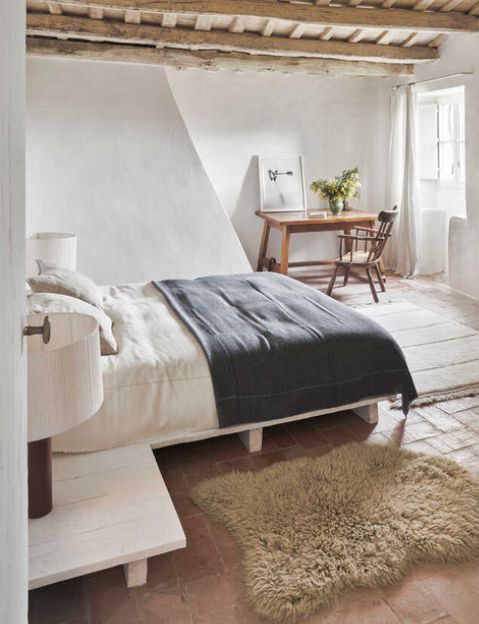
2. lorena canals
- Various rug sizes, shapes + patterns
- Handmade by artisans using recycled materials like organic cotton + wool
- Nontoxic dyes
- Make your own option
- Machine washable
- Rugcycled line made from recycled materials in their own factory
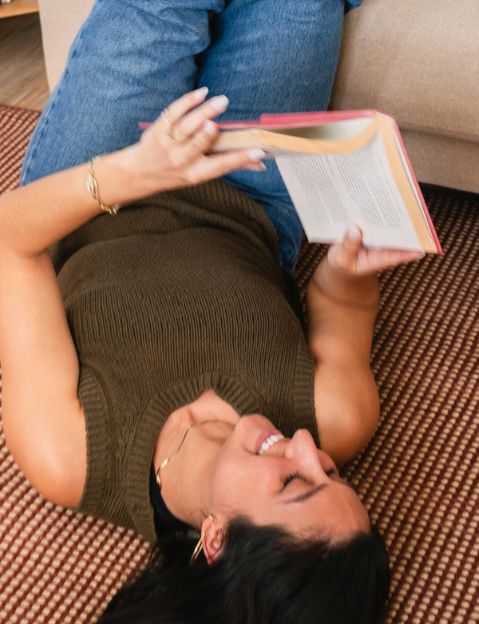
3. sabai
- Field rug
- Woven using wool + jute
- Available in 3 varying sizes
- Rug pad add-on available for reduced movement
- Certified B Corporation

4. quince
- Various sizes + patterns, best known for vintage-inspired looks
- Made from natural materials like wool, jute, + cotton
- Handcrafted by artisans in India
- Transparent pricing practices
- Compostable poly bags + recycled plastic mailers
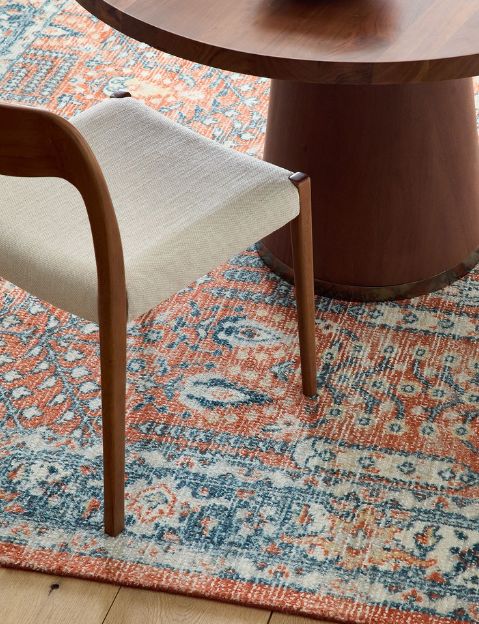
5. west elm
- Rugs for every area of the home, in varying sizes
- Made from wool, jute, hemp, cotton, TENCEL + recycled materials
- Handspun by skilled artisans in India
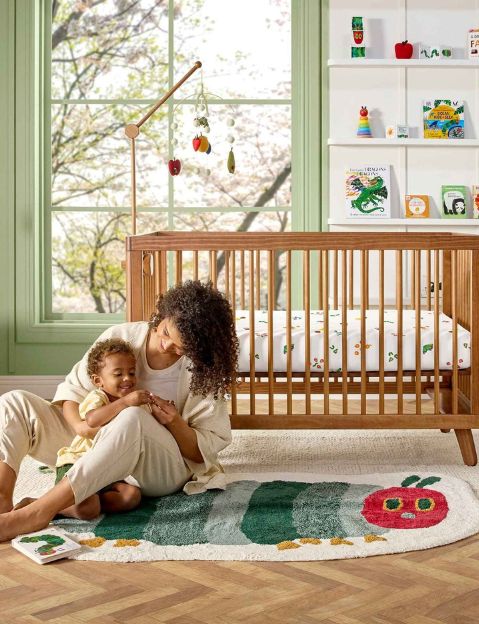
6. nestig
- Area + washable rugs made with fun shapes/designs for babies + kids
- Washable rugs made with organic cotton + nontoxic dyes
- Area rugs made with cotton + each colored element crafted from recycled cotton
- Handmade in Brazil

7. cold picnic
- Various rug shapes + sizes, abstract patterns + bold colors
- Made with wool, bamboo silk, cotton, hemp, + deadstock materials
- Designed in a Brooklyn studio, handmade by artisans in India
- Committed to reducing packaging waste where possible

8. loomy
- Various rug sizes, shapes + patterns
- Made from banana silk, hemp, jute, recycled fiber, viscose, or wool
- Any colored yarn dyed using low-impact techniques
- Handcrafted by indigenous artisans
So what do you think of these non toxic, sustainable rugs? Let me know in the comments!
The post 8 Best Non Toxic Rugs For a Sustainable Home appeared first on Going Zero Waste.
-
Climate Change4 months ago
Guest post: Why China is still building new coal – and when it might stop
-
Greenhouse Gases4 months ago
Guest post: Why China is still building new coal – and when it might stop
-
Climate Change2 years ago
Spanish-language misinformation on renewable energy spreads online, report shows
-

 Greenhouse Gases2 years ago
Greenhouse Gases2 years ago嘉宾来稿:满足中国增长的用电需求 光伏加储能“比新建煤电更实惠”
-
Climate Change Videos2 years ago
The toxic gas flares fuelling Nigeria’s climate change – BBC News
-

 Climate Change2 years ago
Climate Change2 years ago嘉宾来稿:满足中国增长的用电需求 光伏加储能“比新建煤电更实惠”
-

 Carbon Footprint2 years ago
Carbon Footprint2 years agoUS SEC’s Climate Disclosure Rules Spur Renewed Interest in Carbon Credits
-
Renewable Energy5 months ago
US Grid Strain, Possible Allete Sale



